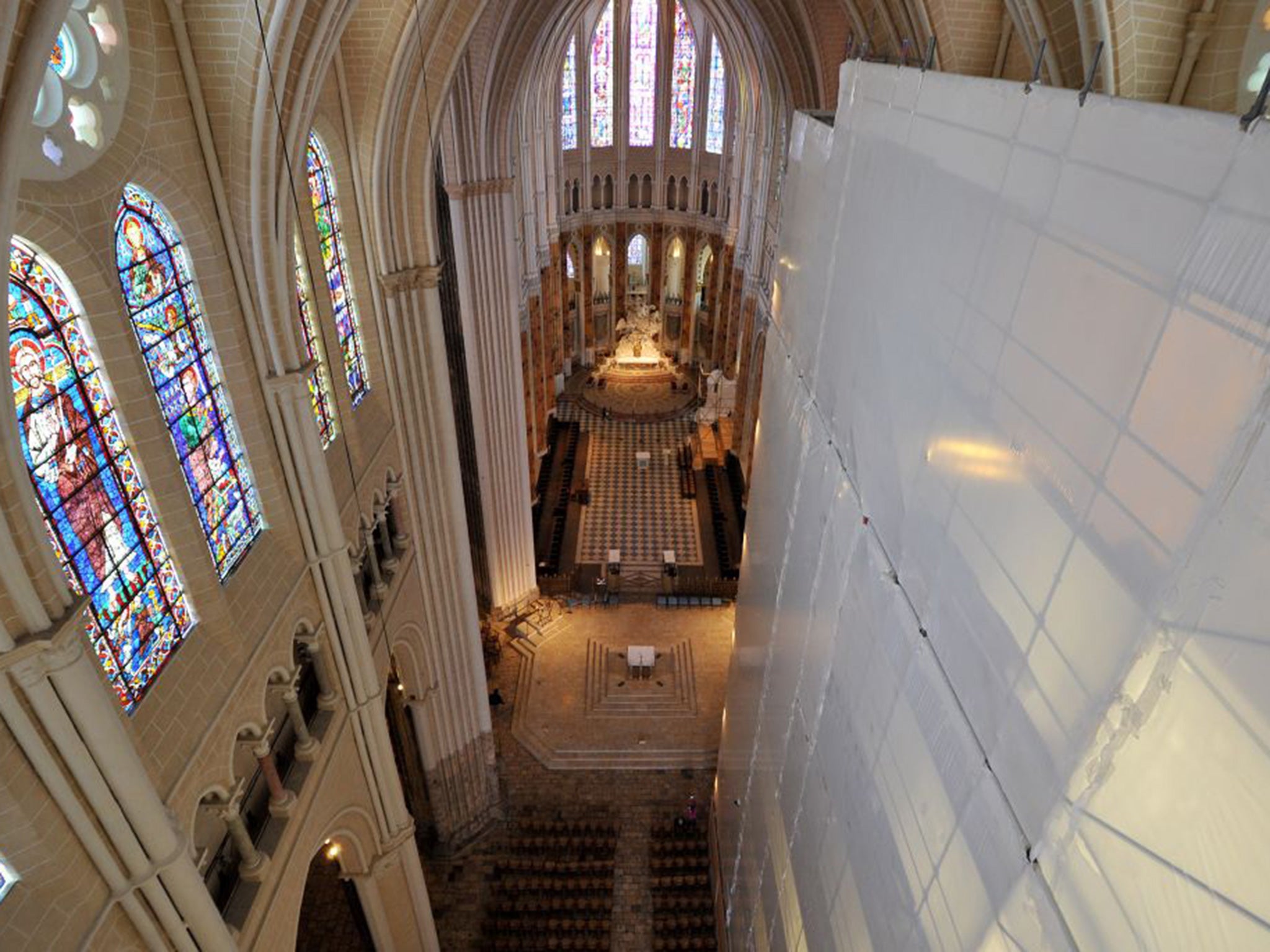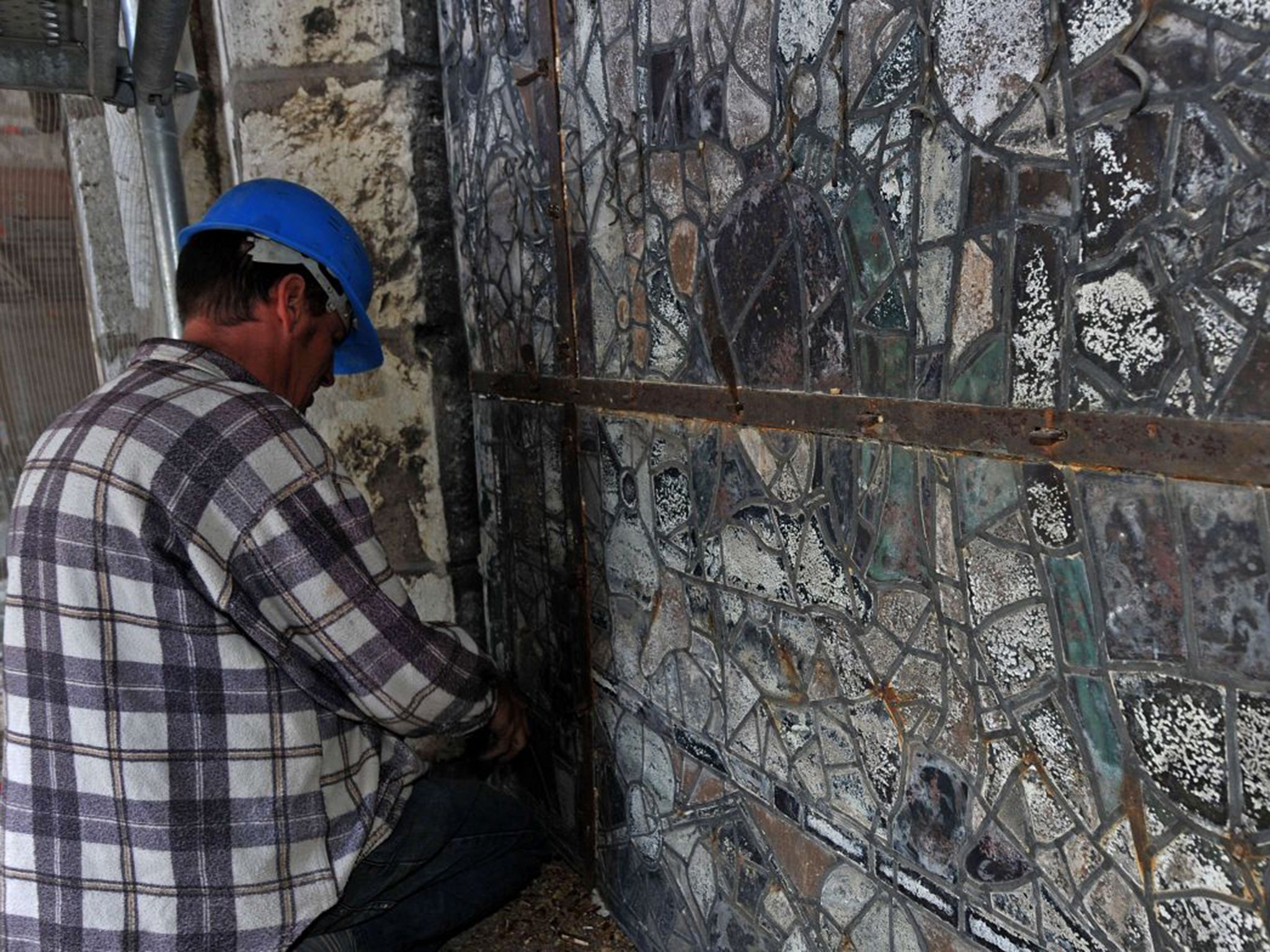Chartres Cathedral clean-up row: Experts divided over whether dirt should be left in place to keep ‘authentic’ Gothic feel
Ambitious internal renovation project has startling effect, but for some architecture lovers it is a disgrace

Your support helps us to tell the story
This election is still a dead heat, according to most polls. In a fight with such wafer-thin margins, we need reporters on the ground talking to the people Trump and Harris are courting. Your support allows us to keep sending journalists to the story.
The Independent is trusted by 27 million Americans from across the entire political spectrum every month. Unlike many other quality news outlets, we choose not to lock you out of our reporting and analysis with paywalls. But quality journalism must still be paid for.
Help us keep bring these critical stories to light. Your support makes all the difference.
Forces of light and darkness are battling for the soul of perhaps the finest of all medieval cathedrals – Chartres, 70 miles south of Paris.
Should 800 years of dirt be left romantically intact? Or should the ceiling and internal walls, black and leprous with grime, be restored to their bright colours of 1225?
Over the past seven years, Chartres has been the subject – or some say the victim – of the most ambitious internal renovation to be undertaken at any Gothic cathedral.
The dingy internal walls are being returned to their original pale ochre hue, with the ceiling and more than half the walls having already been cleaned or repainted. The job should be finished by 2017 or 2018.
The effect is startling – turning the sombre interior of Chartres into something bright and etherial. It is also, according to some, mostly British and American lovers of Gothic architecture, a disgrace.
The British designer and blogger Adam Nathaniel Furman wrote: “A restoration that eliminates the patina of history, and reinstates an illusory ideal moment in the past ... is an act of destruction dressed up in good intentions.”
And Stefan Evans, an American Gothic art specialist, commented: “Irresponsible restoration is erasing history from a Gothic masterpiece.” He then started an online petition to protest against the work.
Six years ago, The Independent visited the cathedral at the start of the restoration and asked: “How would you feel if your great-great-great grandmother was to look 20 years old again?” It seemed certain that some people would feel cheated by the loss of the atmospherically gloomy interior of Chartres.
It was difficult, however, to imagine that it would be, mostly, the British and American experts who would throw their gargoyles out of their prams. A return to Chartres this week meant seeking the views of the greatest authority on the cathedral – Malcolm Miller, 81, who has been giving English language tours of the building for more than half a century. Mr Miller came to Chartres as a student guide from Sutton Coldfield and Durham University in 1958. He stayed on to become – as he says – “part of the fabric of the cathedral”. He has written acclaimed books on Chartres and has twice been decorated by the French state.

Is Mr Miller on the side of light or on the side of darkness? “Just look here,” he said, bouncing angrily towards an uncleaned pillar. He ran his fingers through the grime. “Filth, pure filth,” he said. “Do these people like filth? Do they like cobwebs?
“They talk about the patina of the centuries. Nonsense. Rubbish. This is not the patina of the centuries. It is the rotting remains of a whitewash from the 18th century.”
Mr Miller says it is wrong to believe that Gothic cathedrals were supposed to be sombre. It is equally wrong, he says, to believe that their sombreness is an expression of their great age or an essential component of their mystery.
“The people who built this cathedral intended that its interior should be light,” he said. “There was nothing natural about its darkness. It was nothing to do with ageing of the stone. It was caused, first of all, by centuries of candle smoke and then by a stupid decision to install oil-fired central heating in the 1950s. More recently, there was smoke damage from a couple of fires.”
Chartres has the largest and most complete collection of medieval stained glass windows of any Gothic cathedral – celebrated for their rich colours, especially their deep blues. Some critics mourn the old darkness which, they say, allowed the 11th- and 12th-century windows to shine like jewels through the gloom.
“I don’t see it that way,” Mr Miller said. “This building was conceived as a whole – as a book that people could read. I think that, once completed, the restoration will make the windows part of that whole once again. I think that they will be even more beautiful.”
The €20m (£14.4m) restoration of Chartres – funded by the French state, the European Union and local authorities – is based on the original décor discovered in the 1980s beneath scabrous 18th- and 19th-century white-wash. The original pale ochre sizing, brushed on to the walls when the cathedral was constructed between 1194 and 1225, is being painstakingly uncovered or renewed. And so is the original pattern of “fake”, white, stone joints, which do not follow the lines of the real masonry.

The soaring arches, ribs and columns – the vaulting which made the Gothic cathedrals possible – have been scrubbed from an unsavoury, deep grey to the original bony white. The elaborately carved keystones that hold the roofs together have been repainted to a gleaming red, green, black and gold, based on fragments of the medieval paint that has survived.
The argument against such a radical restoration is eloquently put by the British designer and writer Adam Nathaniel Furman. “The problem with reconstructing supposed origins,” he wrote, “is that a theory, based on necessarily fragmentary and imperfect evidence, is presumed as a final truth.
“All evidence to the contrary... is wiped out and lost for ever as something you can experience... visitors are prevented from forming their own ideas about the building.”
In all the tours I have done since the work began, only a few people have complained. I have rapidly persuaded them that they are wrong
Isabelle Paillot, president of the Friends of Chartres cathedral, believes that all such criticism is misplaced. The restoration work was necessary, she said, to prevent the ancient building from crumbling.
“We do get some complaints from, local people – usually from elderly ones,” she said. “They miss the old, dark interior. They had grown up with it. They think that it is more appropriate for funerals.”
Such complaints, she said, are “vastly outnumbered by the comments of local people and visitors who are bowled over by the restoration”.
“There has been almost no criticism from experts in France – give or take a few tiny details,” she said. “Most of them accept that this is a restoration of what the creators of Chartres Cathedral intended that it should be – a temple of light.”
Who is right? The forces of darkness or the forces of light? “In all the tours I have done since the work began, only a few people have complained,” said Mr Miller. “I have rapidly persuaded them that they are wrong.”
Join our commenting forum
Join thought-provoking conversations, follow other Independent readers and see their replies
Comments